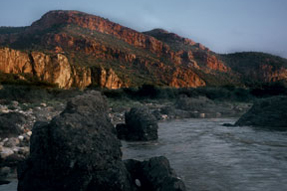Jaguar Reserve Established
February 11, 2008

Privately funded reserve will protect jaguars and imperiled species along U.S.-Mexico border
FOR IMMEDIATE RELEASE: TUCSON, Ariz. – Jaguars in northern Mexico have a newly protected home today thanks to the official establishment of the Northern Jaguar Reserve in Sonora, Mexico. The 45,000-acre reserve, which provides a sanctuary for the world’s northernmost breeding population of jaguars, is the centerpiece of a binational effort by the Northern Jaguar Project and Naturalia to safeguard and restore the jaguar in the U.S.-Mexico borderlands.
“This land is perfectly suited to support North America’s largest wild cat,” said Oscar Moctezuma, director of Naturalia, a respected Mexican conservation organization that will hold title to the property. “The Northern Jaguar Reserve is a dream come true for the many people who have worked hard for its establishment and, most importantly, for the endangered jaguar.”
With assistance from the Northern Jaguar Project, Naturalia purchased the 10,000-acre Rancho Los Pavos in 2003. Located in a region of rich and abundant biodiversity, Los Pavos was the first ranch acquired to establish this viable jaguar reserve.
The Northern Jaguar Project spearheaded the purchase of the $1.5-million Rancho Zetasora, the adjacent 35,000-acre ranch, with generous contributions from more than 600 individual donors and private foundations. The final payment for Zetasora was made at the end of January and completes the 70-square-mile reserve. The Northern Jaguar Reserve has the highest number of jaguar sightings in northern Mexico and is the only reserve where female jaguars have been protected.
“In this remote and rugged area of northern Sonora, a small population of 80 to 120 jaguars struggles to avoid extinction,” said Diana Hadley, president of the Tucson-based Northern Jaguar Project. “The purchase of Zetasora is a crucial step in creating a reserve large enough to effectively protect jaguars as well as dozens of threatened and endangered species.”
“With lengthy frontage on the Aros River, a single, often-impassable road, and deep canyons with deer and other prey, the reserve supports the best possible habitat for northern jaguars,” said Moctezuma.
“The Northern Jaguar Reserve presents a once-in-a-lifetime opportunity to save this species,” said Hadley. “Even if the border fence temporarily blocks jaguar migration, the reserve will help ensure a pathway for jaguars to again roam their former range in the southwestern U.S.”

